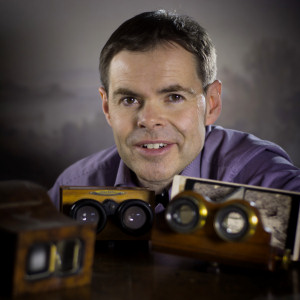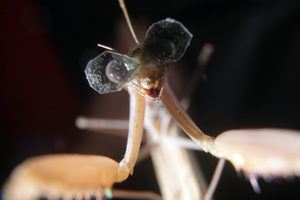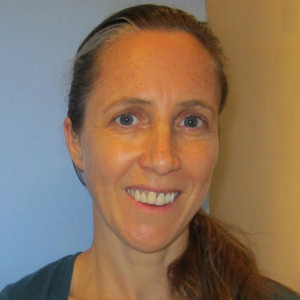
2015 Proceedings
2015 Photos

The World's Premier Conference for 3D Innovation
 |
Videos of many of the presentations at the conference are available for free viewing by clicking on the special "Video" icons |
Monday-Wednesday 9-11 February 2015
Hilton San Francisco Union Square Hotel, San Francisco, California, USA.
To be published as Proceedings of Electronic Imaging, IS&T/SPIE Vol. 9391
Part of IS&T/SPIE's International Symposium on Electronic Imaging: Science and Technology
Sunday-Thursday 8-12 February 2015 ¤ Hilton San Francisco Union Square Hotel,
San Francisco, California, USA
[ Advance Program: Day 1, Day 2, Day 3, Keynote 1, Keynote 2, Demonstration Session, 3D Theatre, Discussion Forum ] [ Register, Short Course ]
|
|
| Monday 9th February 2015 |
| SESSION 1 High Parallax Displays Session Chair: Hideki Kakeya, Univ. of Tsukuba (Japan) |
Mon. 8:30 to 9:10 am |
8:30 am: Enhancement of the effective viewing window for holographic display with amplitude-only SLM, Geeyoung Sung, Jungkwuen An, Hong-Seok Lee, Sun Il Kim, Song Hoon, Juwon Seo, Hojung Kim, Wontaek Seo, Chil-Sung Choi, U-in Chung, Samsung Advanced Institute of Technology (Korea, Republic of) [9391-1]
8:50 am: A full parallax 3D display with restricted viewing zone tracking viewer's eye, Naoto Beppu, Tomohiro Yendo, Nagaoka Univ. of Technology (Japan) [9391-2]
| SD&A Welcome and Opening Remarks | Mon. 9:10 to 9:20 am |
| Coffee Break | 10:20 - 10:50 am |
| SESSION 2 Camera Designs Session Chair: John D. Stern, Intuitive Surgical, Inc. (Retired) (United States) |
Mon. 10:50 am to 12:30 pm |
10:50 am: 3D UHDTV contents production with 2/3 inch sensor cameras,Alaric C. Hamacher, Sunil P. Pardeshi, Kwangwoon Univ. (Korea, Republic of); Taeg Keun Whangboo, Gachon Univ. (Korea, Republic of); SeungHyun Lee, Kwangwoon Univ. (Korea, Republic of) [9391-3]
11:10 am: Integral three-dimensional capture system with enhanced viewing angle by using camera array, Masato Miura, Naoto Okaichi, Jun Arai, Tomoyuki Mishina, NHK Japan Broadcasting Corp. (Japan) [9391-4]
11:30 am: A stereoscopic lens for digital cinema cameras, Lenny Lipton, Leonardo IP (United States); John A. Rupkalvis, StereoScope International (United States) [9391-5]
11:50 am: A novel optical design for light field acquisition using camera array, Mei Zhang, Geng Zheng, Zhaoxing Zhang, Institute of Automation (China) [9391-6]
12:10 pm: Real-time viewpoint image synthesis using strips of multi camera images, Munekazu Date, Hideaki Takada, Akira Kojima, Nippon Telegraph and Telephone Corp. (Japan) [9391-7]
| Lunch Break | 12:30 - 2:00 pm |
| SESSION 3 Applications Session Chair: Takashi Kawai, Waseda Univ. (Japan) |
Mon. 2:00 - 3:20 pm |
2:00 pm: Interactive stereo games to improve vision in children with amblyopia using dichoptic stimulation, Jonathan H. Purdy, Univ. of Bradford (United Kingdom); Alexander Foss, Nottingham Univ. Hospitals NHS Trust (United Kingdom); Richard M. Eastgate, The Univ. of Nottingham (United Kingdom); Daisy MacKeith, Nottingham Univ. Hospitals NHS Trust (United Kingdom); Nicola Herbison, The Univ. of Nottingham (United Kingdom); Anthony Vivian, Nottingham Univ. Hospitals NHS Trust (United Kingdom) [9391-8]
2:20 pm: Stereoscopic visualization of 3D volumetric data for patient-individual skull base prosthesis prior to manufacturing, Justus F. Ilgner, Martin Westhofen, Univ. Hospital Aachen (Germany) [9391-9]
2:40 pm: Visual perception and stereoscopic imaging: an artist's perspective, Steve Mason, Yavapai College (United States) [9391-10]
3:00 pm: Assessing the benefits of stereoscopic displays to visual search: methodology and initial findings, Hayward J. Godwin, Univ. of Southampton (United Kingdom); Nicolas S. Holliman, The Univ. of York (United Kingdom); Tamaryn Menneer, Simon P. Liversedge, Univ. of Southampton (United Kingdom); Kyle R. Cave, Univ. of Massachusetts Amherst (United States); Nicholas Donnelly, Univ. of Southampton (United Kingdom) [9391-11]
| Coffee Break | 3:20 - 4:00 pm |
| SESSION 4 Light Field Displays Session Chair: Hideki Kakeya, Univ. of Tsukuba (Japan) |
Mon. 4:00 to 5:20 pm |
4:00 pm: Small form factor full parallax tiled light field display , Zahir Y. Alpaslan, Hussein S. El-Ghoroury, Ostendo Technologies, Inc. (United States) [9391-12]
4:20 pm: Load-balancing multi-LCD light field display, Xuan Cao, Zheng Geng, Mei Zhang, Xiao Zhang, Institute of Automation (China) [9391-13]
4:40 pm: Light field display simulation for light field quality assessment, Rie Matsubara, Zahir Y. Alpaslan, Hussein S. El-Ghoroury, Ostendo Technologies, Inc. (United States) [9391-14]
5:00 pm: Integration of real-time 3D capture, reconstruction, and light-field display, Zhaoxing Zhang, Zheng Geng, Tuotuo Li, Institute of Automation (China); Yongchun Liu, Nanjing Univ. of Aeronautics and Astronautics (China); Xiao Zhang, Jiangsu Univ. (China) [9391-15]
This ever-popular event allows attendees to see large-screen examples of 3D content from around the world. Program announced at the conference. 3D glasses provided.
|
The annual informal dinner for SD&A attendees. An opportunity to meet with colleagues and discuss the latest advances. There is no host for the dinner. Information on venue and cost will be provided on the day at the conference. |
| Tuesday 10th February 2014 |
|
| SESSION 5 Autostereoscopic Displays Session Chair: Hideki Kakeya, Univ. of Tsukuba (Japan) |
Tue. 10:10 am - 11:30 pm |
10:10 am: A large 1D retroreflective autostereoscopic display, Quinn Y. Smithwick, Disney Research, Los Angeles (United States); Nicola Ranieri, ETH Zürich (Switzerland) [9391-16]
10:30 am: Time-sequential lenticular display with layered LCD panels, Hironobu Gotoda, National Institute of Informatics (Japan) [9391-17]
10:50 am: Dual side transparent OLED 3D display using Gabor super-lens, Sergey Chestak, Dae-Sik Kim, Sung-Woo Cho, SAMSUNG Electronics Co., Ltd. (Korea, Republic of) [9391-18]
11:10 am: 360-degree three-dimensional flat panel display using holographic optical elements, Hirofumi Yabu, Osaka City Univ. (Japan); Kayo Yoshimoto, Osaka Univ. (Japan); Hideya Takahashi, Osaka City Univ. (Japan); Kenji Yamada, Osaka Univ. (Japan) [9391-19]
| ||||||||||
| Lunch Break | 12:30 - 2:00 pm |
| SESSION 6 Human Factors and Performance Session Chair: John O. Merritt, The Merritt Group (United States) |
Tue. 2:00 - 3:30 pm |
2:00 pm: Subjective contrast sensitivity function assessment in stereoscopic viewing of Gabor patches, Johanna Rousson, Jérémy Haar, Barco N.V. (Belgium); Ljiljana Platiša, Univ. Gent (Belgium); Arnout Vetsuypens, Bastian Piepers, Tom R. Kimpe, Barco N.V. (Belgium); Wilfried Philips, Univ. Gent (Belgium) [9391-20]
2:20 pm: An objective method for 3D quality prediction using perceptual thresholds and acceptability, Darya Khaustova, Orange SA (France); Olivier Le Meur, Univ. de Rennes 1 (France); Jerome Fournier, Emmanuel Wyckens, Orange SA (France) [9391-21]
2:40 pm: Disparity modification in stereoscopic images for emotional enhancement, Takashi Kawai, Daiki Atsuta, Sanghyun Kim, Waseda Univ. (Japan); Jukka P. Häkkinen, Univ. of Helsinki (Finland) [9391-22]
3:00 pm: Preference for motion and depth in 3D film, Brittney A. Hartle, York Univ. (Canada); Arthur Lugtigheid, Univ. of Southampton (United Kingdom); Ali Kazimi, Robert S. Allison, Laurie M. Wilcox, York Univ. (Canada) [9391-23]
| Coffee Break | 3:20 - 4:00 pm |
| SESSION 7 Visual Comfort Studies Session Chair: Takashi Kawai, Waseda Univ. (Japan) |
Tue. 4:00 - 5:20 pm |
4:00 pm: Microstereopsis is good, but orthostereopsis is better: precision alignment task performance and viewer discomfort with a stereoscopic 3D display, John P. McIntire, Paul R. Havig, Air Force Research Lab. (United States); Lawrence K. Harrington, Ball Aerospace & Technologies Corp. (United States); Steve T. Wright, U.S. Air Force (United States); Scott N. J. Watamaniuk, Wright State Univ. (United States); Eric L. Heft, Air Force Research Lab. (United States) [9391-24]
4:20 pm: Effects of blurring and vertical misalignment on visual fatigue of stereoscopic displays, Sangwook Baek, Chulhee Lee, Yonsei Univ. (Korea, Republic of) [9391-25]
4:40 pm: Subjective and objective evaluation of visual fatigue on viewing 3D display continuously, Danli Wang, Yaohua Xie, Yang Lu, Institute of Software (China) [9391-26]
5:00 pm: Study of objective parameters of 3D visual fatigue based on RDS related tasks, Yi Huang, Yue Liu, Bochao Zou, Dongdong Weng, Beijing Institute of Technology (China) [9391-27]
| ||
|
Demonstrations
A symposium-wide demonstration session will be open to attendees 5:30 to 7:30 pm Tuesday evening. Demonstrators will provide interactive, hands-on demonstrations of a wide-range of products related to Electronic Imaging. The session will have a focused "Stereoscopic Displays and Applications" area. The demonstration session hosts a vast collection of stereoscopic products providing a perfect opportunity to witness a wide array of stereoscopic displays with your own two eyes. | ||
|
Posters The poster session, with authors present, will be held Tuesday evening. The full listing of poster papers appears below. |
| Interactive Paper (Poster) Session Interactive papers will be placed on display after 10:00 am on Tuesday. An interactive paper session, with authors present at their papers, will be held Tuesday evening. Refreshments will be served. The Interactive Paper (Poster) Session runs in parallel with the SD&A / EI Symposium Demonstration Session. |
Tue. 5:30 - 7:00 pm |
- Enhancement of viewing angle with homogenized brightness for autostereoscopic display with lens-based directional backlight, Takuya Mukai, Hideki Kakeya, Univ. of Tsukuba (Japan) [9391-40]

- Effect of Petzval curvature on integral imaging display, Ganbat Baasantseren, National Univ. of Mongolia (Mongolia) [9391-41]

- [9391-42] moved to Session 8
- Free-viewpoint video synthesis from mixed resolution multi-view images and low resolution depth maps, Takaaki Emori, Nagoya Univ. Graduate School of Engineering (Japan); Mehrdad Panahpour Tehrani, Keita Takahashi, Nagoya Univ. (Japan); Toshiaki Fujii, Nagoya Univ. Graduate School of Engineering (Japan) [9391-43]

- Formalizing the potential of stereoscopic 3D user experience in interactive entertainment, Jonas Schild, Consultant (Germany) [9391-44]

Development of binocular eye tracker system via virtual data, Frank Hofmeyer, Sara Kepplinger, Technische Univ. Ilmenau (Germany); Manuel Leonhardt, Nikolaus Hottong, Hochschule Furtwangen Univ. (Germany) [9391-45]- Two CCD cameras stereoscopic position measurement for multi fiber positioners on ground-based telescope, Zengxiang Zhou, Hongzhuan Hu, Jianping Wang, Jiaru Chu, Zhigang Liu, Univ. of Science and Technology of China (China) [9391-46]
- Usability of stereoscopic view in teleoperation, Wutthigrai Boonsuk, Eastern Illinois Univ. (United States) [9391-47]

- Using binocular and monocular properties for the construction of a quality assessment metric for stereoscopic images, Mohamed-Chaker Larabi, Univ. of Poitiers (France); Iana Iatsun, XLIM-SIC (France) [9391-48]
- Dynamic mapping for multiview autostereoscopic displays, Jing Liu, Univ. of California, Santa Cruz (United States); Tom Malzbender, Cultural Heritage Imaging (United States); Siyang Qin, Bipeng Zhang, Che-An Wu, James Davis, Univ. of California, Santa Cruz (United States) [9391-51]

| Wednesday 11th February 2014 |
|
| Coffee Break | 9:50 - 10:10 am |
| SESSION 8 Image Processing Session Chair: Davide Gadia, Univ. degli Studi di Milano (Italy) |
Wed. 10:10 - 11:30 am |
10:10 am: Multi-view stereo image synthesis using binocular symmetry based global optimization, Hak Gu Kim, Yong Ju Jung, Soosung Yoon, Yong Man Ro, KAIST (Korea, Republic of) [9391-28]
10:30 am: Depth assisted compression of full parallax light fields, Danillo Graziosi, Zahir Y. Alpaslan, Hussein S. El-Ghoroury, Ostendo Technologies, Inc. (United States) [9391-29]
10:50 am: A 3D mosaic algorithm using disparity map, Bo Yu, Hideki Kakeya, Univ. of Tsukuba (Japan) [9391-30]
11:10 am: Data conversion from multi-view cameras to layered light field display for aliasing-free 3D visualization, Toyohiro Saito, Keita Takahashi, Mehrdad P. Tehrani, Toshiaki Fujii, Nagoya Univ. (Japan) [9391-42] Post inserted object calibration for stereo video rectification, Weiming Li, Samsung Advanced Institute of Technology (China) [9391-31]
Stereoscopic 3D is now a well established tool for film making in cinema and television. The stereography of good 3D has been an important part of this process, enabling the best content to produce both compelling and entertaining depth sensations. We know that this success has come from an understanding of what is good in human terms, in display terms and in content terms. Our panel of distinguished researchers in the fields of 3D and VR will discuss the role good 3D has in the VR experience. In particular is good stereoscopic 3D necessary for VR to be immersive and compelling.
Moderator: Panellists: |
| Lunch Break | 12:30 to 2:00 pm |
| SESSION 9 Multi-View and Integral Imaging Displays Session Chair: Hideki Kakeya, Univ. of Tsukuba (Japan) |
Wed. 2:00 - 3:20 pm |
2:00 pm: A new type of multiview display, René de la Barré, Fraunhofer-Institut für Nachrichtentechnik Heinrich-Hertz-Institut (Germany); Silvio Jurk, Technical Univ. Berlin (Germany); Mathias Kuhlmey, Fraunhofer-Institut für Nachrichtentechnik Heinrich-Hertz-Institut (Germany) [9391-32]
2:20 pm: Compact multi-projection 3D display using a wedge prism, Byoungho Lee, Soon-gi Park, Chang-Kun Lee, Seoul National Univ. (Korea, Republic of) [9391-33]
2:40 pm: Integral 3D display using multiple LCDs, Naoto Okaichi, Masato Miura, Jun Arai, Tomoyuki Mishina, NHK Japan Broadcasting Corp. (Japan) [9391-34]
3:00 pm: A super multi-view display with small viewing zone tracking using directional backlight, Jin Miyazaki, Tomohiro Yendo, Nagaoka Univ. of Technology (Japan) [9391-35]
| Coffee Break | 3:20 - 3:50 pm |
| SESSION 10 Image Production and Perception Session Chair: Davide Gadia, Univ. degli Studi di Milano (Italy) |
Wed. 3:50 - 5:10 pm |
3:50 pm: Real object-based 360 degree integral-floating display using multi depth camera, Munkh-Uchral Erdenebat, Erkhembaatar Dashdavaa, Ki-Chul Kwon, Kwan-Hee Yoo, Nam Kim, Chungbuk National Univ. (Korea, Republic of) [9391-36]
4:10 pm: Multi-layer 3D imaging using multiple viewpoint images and depth map, Hidetsugu Suginohara, Hirotaka Sakamoto, Satoshi Yamanaka, Mitsubishi Electric Corp. (Japan); Shiro Suyama, Univ. of Tokushima (Japan); Hirotsugu Yamamoto, Utsunomiya Univ. (Japan), The Univ. of Tokushima (Japan) [9391-37]
4:30 pm: Evaluation of vision training using 3D play game, Jungho Kim, Soon Chul Kwon, Kwang-Chul Son, SeungHyun Lee, Kwangwoon Univ. (Korea, Republic of) [9391-38]
4:50 pm: Partially converted stereoscopic images and the effects on visual attention and memory, Sanghyun Kim, Waseda Univ. (Japan); Hiroyuki Morikawa, Aoyama Gakuin Univ. (Japan); Reiko Mitsuya, Takashi Kawai, Waseda Univ. (Japan); Katsumi Watanabe, The Univ. of Tokyo (Japan) [9391-39]
|
| Meal Break Time to grab a meal in a local San Francisco restaurant (while all the EI conference chairs have their big annual planning session). Don't forget to come back at 8:00pm for the All-Conference Dessert Reception. |
5:30 to 8:00 pm |
The annual Electronic Imaging All-Conference Reception provides a wonderful opportunity to get to know and interact with new and old SD&A colleagues. Plan to join us for this relaxing and enjoyable event. |





 Stereo vision incurs significant costs, e.g. the duplication of resources to cover a region of the visual field twice, and the neuronal tissue needed to extract disparities. Nevertheless, it has evolved in many animals including monkeys, owls, horses, sheep, toads and insects. It must therefore convey significant fitness benefits. It is often assumed that the main benefit is improved accuracy of depth judgments, but camouflage breaking may be as important, particularly in predatory animals. I will discuss my lab's attempts to gain insight into these questions by studying stereo vision in an insect system, the praying mantis.
Stereo vision incurs significant costs, e.g. the duplication of resources to cover a region of the visual field twice, and the neuronal tissue needed to extract disparities. Nevertheless, it has evolved in many animals including monkeys, owls, horses, sheep, toads and insects. It must therefore convey significant fitness benefits. It is often assumed that the main benefit is improved accuracy of depth judgments, but camouflage breaking may be as important, particularly in predatory animals. I will discuss my lab's attempts to gain insight into these questions by studying stereo vision in an insect system, the praying mantis.


